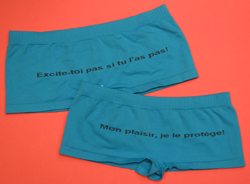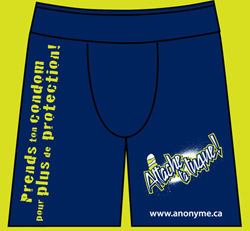What is the Program?

The “Hey fille! Mets tes culottes!” and “Attache ta tuque! Fais un homme de toi!” programs (which translate roughly to “Hey Girl! Put On Your Pants!” and “Hang On to Your Hat! Make a Man of Yourself!” and are collectively referred to in this case study as “The Underwear Project”) encourage young women and men in Montreal’s Saint-Michel neighbourhood to practice safer sex despite conflicting pressures related to expected gender roles from families, sexual partners, peers and the community in general. The crux of this program is outreach to youth using underwear bearing peer-developed safer-sex messages.

While a select number of youth participate in a focus group to create peer-based messaging around safer sex, the majority of participants are engaged during the program’s one-on-one outreach stage in which the underwear with the safer-sex messaging is distributed to participants by service providers, serving as a departure point for deeper discussions about sexual health. The underwear comes attached with a condom and a wallet-sized resource card that lists contact information for multiple youth-focused services, including a teen help line, resources on where to access housing, legal rights, and nearby clinics offering reproductive and sexual health services and HIV, STI and pregnancy testing.
Furthermore, the goal is for the underwear to serve as an ongoing tool to engage youth in safer sex: By wearing the slogan in such an intimate place and by associating it so closely with their sexuality, participants can keep the concepts of safer sex that have been discussed with service providers during outreach clearly in mind. When the young women and men wear their unique underwear, it can serve as a discussion point for safer sex with their peers and sexual partners.
Note: The one-on-one outreach using the slogan-bearing underwear happens in institutions where l’Anonyme also presents a series of workshops on sexual health. These workshops complement the Underwear Project but are out of the scope of the present case study.
Why Was the Program Developed?
In 2004, L’Anonyme initiated the “Mets tes culottes!” (“Put on your pants!”) project to educate sex workers, people who use drugs and street-involved youth about sexual health. It was based on a political protest campaign in the United States during which women wrote anti-George W. Bush slogans on their underwear, which L’Anonyme adapted to suit its mobile outreach unit, printing both women’s and men’s underwear with safer-sex messages and distributing them during outreach. L’Anonyme also provided training to partner agencies for implementing “Mets tes culottes!” The project ended in 2007, after groups serving these populations in Montreal and Quebec City had received training and underwear to distribute.
Through the work of its mobile outreach unit, a considerable need for education about sex and HIV and STIs in Montreal’s Saint-Michel neighbourhood—particularly among groups that were not targeted by the original project, such as young women, some of whom were mothers—was identified by both field observations and data reported by neighbourhood organizations.
To serve these young women, the original project was adapted into the “Hey fille! Mets tes culottes!” (“Hey Girl! Put on your pants!”) in 2007. Several schools and community centres serving at risk youth were engaged in delivering the project, and young women were engaged in selecting their own safer-sex messaging to be printed on the underwear, which were, in turn, distributed through the program.
In 2009, the project was again successfully adapted—this time for the young men of the neighbourhood—to become “Attache ta tuque! Fais un home de toi!” (“Hang On to Your Hat! Make a Man of Yourself!”)
The program was adapted by selecting new themes for the training that were more relevant to the men (such as “masculinity and stereotypes”), choosing men’s underwear on which to print slogans and engaging other area high schools and community organizations in the project.
What’s in a name?
In Canadian French, the term “Mets tes culottes” means “Put on your pants” (or “panties”), which means “take responsibility.”
“Attache ta tuque” means “Hang on to your hat,” which means “get ready,” as it does in English, with an emphasis on “keeping your wits about you.”
How Does the Program Work?
The Underwear Project is delivered in almost exactly the same manner to young women and young men. Only the name of the program (“Hey fille!” for young women, “Attache ta tuque!” for young men) and the type of underwear distributed differs. During the outreach component of the program, however, service providers are invited to tailor their approach to one-on-one outreach to meet the specific needs of the individual they engage in discussion about the project. The service providers can choose to run the project for either men or women or both.
The project has two distinct components:
- Creation of underwear including the selection of slogans (through focus groups with youth)
- Service provider training and outreach to youth
During slogan selection, youth are consulted in focus groups to brainstorm possible slogans for the underwear (which are distributed in the outreach stage of the program) based on relevant sexual health topics.
Outreach workers and educators who have agreed to use the underwear to engage youth in discussions on safer sex in their organizations participate in a half-day training to prepare for ongoing outreach (on prevention issues using the underwear as a tool) based on the Information, Motivation, Behavioural skills model. They, in turn, engage youth in deeper discussions of sexual health by presenting them with underwear bearing the safer-sex slogan designed by their peers. For more information on the IMB approach, see Other Useful Resources.
Location
The staff of L’Anonyme generally conduct focus groups with youth in a meeting space within the school/organization that has signed on to the project. This space is usually the same one in which the service provider from the participating organization also meets with youth. This can help the youth feel comfortable, as they are already familiar with the space.
Training for service providers can take place in meeting rooms at partner organizations or community health centres or anywhere that is relatively quiet and accessible to all participating service providers.
After the focus groups and training, the service providers continue one-on-one outreach with the youth within their institutions as opportunity arises and scheduling permits.
Recruitment and Engagement
Service Providers
L’Anonyme has been building relationships with key institutions serving youth in the Saint-Michel neighbourhood for more than five years and has established an advisory committee consisting of project partners, including key service providers (educators, outreach workers, nurses, facilitators, etc.) at schools, youth centres, community organizations and local community service centres.
L’Anonyme begins the implementation of a “Hey fille!” or “Attache ta tuque!” program months before it officially begins by sending a letter of commitment to the directors of partner organizations that have expressed a willingness to participate. Members of these organizations may have expressed support during informal discussions at local community events or during consultations with L’Anonyme staff. The letter of commitment serves to reinforce a commitment at an organizational level.
The Project Coordinator follows up to schedule trainings (for service providers) and focus groups (with youth).
Participants
Once the service providers have confirmed their own participation and have identified dates when focus groups will occur, they recruit participants (youth) from within their institutions by promoting focus groups through word of mouth and within their regular forms of communication (newsletters, organizational calendars, bulletin boards, etc.). Meals and/or refreshments are offered as incentives for participation.
Service providers determine how many focus groups they will host based on the interest expressed by the youth in their institution and time constraints. Each focus group is promoted separately no more than a few weeks before it is scheduled to occur. In L’Anonyme’s experience, giving more advance notice merely diffuses the message and doesn’t increase participation.
Training
Service providers who are implementing the program within their institutions are engaged in a half-day training that:
- Introduces L’Anonyme
- Provides an overview of The Underwear Project
- Describes the need for prevention projects and how they work
- Gives an overview of risk factors linked to STIs and HIV
- Explains how the program’s underwear can be used as an educational tool
At the end of the training, service providers have a chance to share experiences, ask questions and address concerns. They also have a chance to practice using the distribution of the underwear as a way to initiate intimate discussions with youth about sexual health. This helps them anticipate questions and situations that may arise. During the training, they receive a guide to one-on-one outreach.
For examples of some of L’Anonyme’s training materials, please see Program Materials.
Notes from L’Anonyme for effective sex education among young people in their community:
- Be specific, factual, descriptive.
- Try to conduct outreach in an informal context, such as during a sports or arts activity.
- Use illustrations relevant to youth: music, sports, popular films, etc.
Specific notes for effective sex education among young men:
- Recognize the appetite for risk among some young men.
- Be sensitive to pressures to adhere to masculine stereotypes that may be exerted on young men by their family, community or peers.
- Consider how boys behave in groups (some boys exaggerate their sexual behaviours).
Specific notes for effective sex education among young women:
- Recognize the pressure to perform sexually that may be exerted on young women by their peers and intimate partners.
- Be sensitive to conflicting pressures to be “non-sexual” that may be exerted on them by parents and community leaders.
- Consider how girls behave in groups (some girls hide their sexual behaviours).
Focus Groups

The purpose of the focus groups is to engage young women or men in the creation of new safer-sex slogans to be printed on underwear that will eventually be distributed to their peers. Each focus group generally includes eight to 10 youth.
As the “Hey fille! Mets tes culottes!” program focuses on reaching out to young women, an organization implementing “Hey fille!” will invite only women to participate in a focus group. Similarly, the focus group in “Attache ta tuque!” includes young men only. Participating in a focus group offers youth the chance to be active in the creation of a social marketing campaign to promote sexual health. They are also provided refreshments and an opportunity to socialize with their peers around a unique topic of conversation.
Each focus group is led by a facilitator from L’Anonyme. In one 60- to 90-minute session, participants are given an overview of the project and asked to fill out a short questionnaire to assess their knowledge, motivations and skills related to sexual health in order to help generate conversation and set the tone of the brainstorming to follow.
While the facilitator will address questions and discuss some basics on HIV/STI prevention at this time, this is not meant to be an HIV/STI outreach or education session. The purpose of the focus group is to find out what types of slogans resonate with participants before they have been exposed to more in-depth HIV/STI information so that the slogan speaks in the language of the participants and their peers.
To stimulate the creative process, participants are presented examples of safer-sex slogans from previous campaigns (whether peer-based or not). Collectively, they speak about which slogans they do and don’t like, then brainstorm ideas for new slogans.
Participants break into groups of three or four. Each group is given a pair of underwear and asked to choose one of the slogans or to invent their own. They are asked to be creative in incorporating the logos of both L’Anonyme and The Underwear Project—as well as their own chosen slogan—into the underwear design by using a marker or paper cut-outs.
One member from each group reports back to the larger group, attempting to “sell” their slogan and presentation to their peers. Participants vote to select their favourites. The session concludes with participants sharing refreshments or a meal.
After all focus groups have finished selecting their favourite slogans, the staff from L’Anonyme meet to make a final selection, choosing the slogan(s) that is the most accurate in terms of sexual health information and that may have the biggest impact. Over the next few months, the underwear design is finalized by L’Anonyme and copies are made for all participating institutions. L’Anonyme has produced two different underwear designs per project to give youth the chance to select their favourite.
L’Anonyme produces about 1,200 pairs of underwear per year, with the amount being determined by the project budget and circulated according to the demand from participating community organizations.
Service Provider Outreach
Once the underwear has been printed with the slogan, it is distributed to the service provider at each participating institution. This individual determines how best to distribute the underwear in his or her classes, activities and other events. The purpose is for the underwear to be used as a tool for engaging young people in meaningful conversations about sexual health.
Outreach with youth can be done either in groups or one-on-one. The underwear is a useful tool to engage youth at any moment when there is an opportunity for deeper discussion about sexual health to take place. For example, the underwear may be distributed during a group discussion on sexuality at a youth centre in which a strong rapport between the facilitator and participants has been established.
Ideally, a one-on-one approach to outreach provides the optimal condition for exploring individual concerns. A school counsellor, for example, may distribute the underwear individually to students when they come to her for personal advice. In this intimate setting, the counsellor can use the underwear as a way of sparking a conversation about challenges the young man or woman may face when it comes to practicing safer sex.
When presenting the underwear, it is suggested that it be taken out of its packaging to prominently display the attached condom and wallet-sized resources card, which contains details of the project partners as well as many useful resources on sexual health.
Though participants in the program may each receive underwear at different times under different circumstances, the launch of the underwear campaign can serve as a unifying event in the school and/or neighbourhood. As more and more young people receive the garments, word of mouth can spread, turning the underwear into an iconic symbol to those who have obtained them. In other words, they can achieve a cult-like status among youth who associate them with being “cool.”
Required Resources
Human resources
A Project Coordinator is required to centrally manage the program, and experienced service providers already working with youth in schools and community organizations are required to conduct the actual outreach.
Project Coordinator
- Comfortable discussing sex with young women and men and with challenging them to question myths and misinformation about sex and stereotypes associated with “appropriate” gender-specific behaviour with their peers
- Flexible in working with service providers from the different partner organizations that form the advisory committee
- Skilled at developing, organizing and facilitating trainings for service providers
Service Providers
- Comfortable discussing sex with young women and men and with challenging them to question myths and misinformation about sexuality and “appropriate” gender-specific behaviour in groups of their peers
- Interested in preventing transmission of HIV and STIs
- Committed to providing ongoing year-round support to young people in their community, storing resources in their offices for distribution and serving as a liaison between the Project Coordinator and the institution staff
Material resources
- Printed materials (project guides, brochures, resource cards for underwear)
- Underwear
- Food to be served at focus groups to encourage participation
- Condoms
Financial resources
Excluding administration fees and salaries, approximate costs of the major expenses for running the program in Montreal are:
- 1,200 pairs of underwear printed with slogans – $9,000
- Refreshments for focus groups – $40 to $50 for an event hosting eight participants
- Project guides for facilitators – $12 to $20 per guide
While this project has its own funding (ACAP), partner organizations contribute generously by lending their facilities, equipment and outreach workers to the project. Condoms attached to the underwear are supplied by the Montreal Department of Public Health.
Challenges
- Creating a slogan through a series of focus groups, then printing the slogan on underwear and distributing the underwear through trained service providers involves a complex series of steps and resources.
- Different levels of commitment from different service providers at different organizations can make scheduling of trainings and focus groups a challenge.
- Evaluating the impact of the program can be challenging, as the effect of safer-sex slogans on behaviour is difficult if not impossible to measure objectively, particularly among youth who may be adjusting to the many cultural and social dynamics the program attempts to address in its outreach efforts.
Evaluation
The advisory committee gauges the effectiveness of the program by surveying both young participants and the service providers who work with them. Surveys are administered to evaluate:
- The satisfaction of service providers with training
- The satisfaction of young people participating in focus groups
- The changes in behaviour, knowledge and attitudes in young participants according to their own perception and as perceived by service providers who have engaged them in discussions related to HIV/STIs with the help of the slogan-bearing underwear
Over the course of the “Hey fille!” and “Attache ta tuque!” programs from 2007-2010:
- 15 trainings were offered to 78 service providers, and each training was adapted to the needs of the specific community where the training took place. The vast majority of trainees said they felt they acquired new transferable knowledge on HIV and STIs during the training.
- 3,600 pairs of underwear (each with a condom and resource card attached) were distributed.
- The majority of service providers said they felt that the underwear helped facilitate meaningful discussions about sexual health with the young women and men they reached out to.
Lessons Learned
- Involving youth in the creation of a safer-sex campaign aimed at other youth improves overall engagement in the campaign
- A safer-sex campaign that includes the distribution of a somewhat unorthodox take-away item, such as a pair of underwear with a safer-sex slogan, creates a “buzz” that helps generate interest and discussion.
- Youth often receive conflicting messages about sexuality from family, community leaders and peers, making consistency of messaging in sexual health outreach essential.
- Some young men may exaggerate their sexual experiences when discussing sexuality among their peers, making one-on-one discussions important when assessing their challenges negotiating and concerns around sexual health.
- Some young women may disguise their sexual experience in a group setting to avoid judgment of their peers and/or leaders, making one-on-one discussions important when assessing their challenges negotiating and concerns around sexual health.
Program Materials
- Attache ta tuque ! Fais un homme de toi ! Description et originalité du project
- Analyse des besoins : « Attache ta tuque ! Fais un homme de toi ! »
- Manuel pour le projet « Attache ta tuque! Fais un homme de toi! »
- Manuel pour le projet « Hey fille ! Mets tes culottes ! »
- Affiche du Attache ta tuque! Fais un homme de toi!
- Questionnaires des programmes Hey fille! Mets tes culottes ! at Attache ta tuque ! Fais un homme de toi !
- Tags pour sous-vêtements pour les projets « Attache ta tuque! Fais un homme de toi! » et « Hey fille! Mets tes culottes! »
- Attache ta tuque ! Fais un homme de toi ! Fiche d'evaluation
- Attache ta tuque ! Fais un homme de toi ! Formation destinée aux intervenants
Contact Information
For more information on The Underwear Project, please contact:
Marjolaine Dionne
Sexologue Clinicienne
L’Anonyme
5600, rue Hochelaga #160
Montréal PQ H1N 3L7
(514) 842-1488
marjolaine.anonyme@gmail.com
www.anonyme.ca

